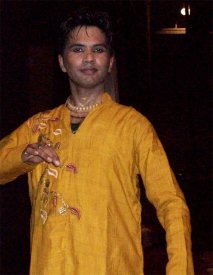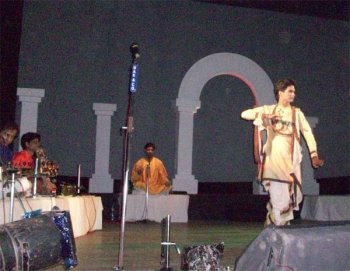
|   |

|   |
Nadam’s Shanti Bhavna -A tribute to the victims of Nov 26,’08 - Nita Vidyarthi, Kolkata e-mail: nitavidyarthi@gmail.com July 3, 2011 Nadam paid tribute to the victims of Nov 26, ’08 in Mumbai, through a charged musical and dance presentation entitled ‘Shanti Bhavna’ at Kalamandir. The concept and choreography by the upcoming Kathak dancer Sandip Mullick and his ‘Musical Seven’ was a Kathak concert uniting the dancer Sandip Mullick in a platform with well known musicians, vocalist Sounak Chatterjee, tabaliyas Biplab Bhattacharyya, Soumen Sarkar, Ujjwal Bharati, with Sunanda Mukherjee on the sarod, Soumen Bhattacharyya on the sitar and Umesh Mishra on the sarangi.  Shanti Bhavna was structured as a journey by dancer Sandip Mullick who meets different people, different sets of musicians during his travel from one land to another exploring human values and qualities, well presented by setting the different combinations of musicians at different positions of the stage on which the spotlight falls. Mullick’s interaction with them through the interplay of music, tempo, different ragas and talas is portrayed through his deft movements exploiting all the elements of Kathak. Shlokas from Upanishad, kirtans of some 500 years ago and early Islamic Khayal compositions are transformed into beautiful dance, pure dance numbers, nritta, nritya and some abhinaya. Being a disciple of Pandit Kumar Bose, Sandip is very well trained into the details of talas and layakari and this strength he combines with his expertise in dance to transform into a clear and impressive experience. Entering with the chants of “Om tyame sharanam Maheshswaram,” Sandip moves to present pure dance numbers in taal Dhamar to interact rhythmically with the first set of people, the tabaliya Ujjwal Bharati, with the strokes of sarod and sarangi by the respective musicians. Vibrant dancing accompanied the Dhamar paranth ka bols and talas of pakhawaj in joda and some compositions of his Guru Sreelekha Mukherjee that were adorned with challans by Pandit Birju Maharaj. The naghma followed on the sarod was uncommon as was the fine “dha takey thunga tihai” in a cycle of 7. Here depiction of horse riding in energetic movements thrilled the audience.  Costumes changed as the dancer travels to a different land, meets different sets of musicians to present fine tihais, in abstract number combinations, amad and sawal –jawaab in Jhaptaal. Biplab Bhattacharyya accompanies him as Raga Kedar reverberates in the lovely voice of the vocalist. Nritya sprinkled with abhinaya was well appreciated in the Khayal “Araj dasta meri.” More than the sufi-andaz of the dancer with movements of the swirling dervish and 101 chakkars, the soul-stirring rendition of the vocalist, the intensity of sarod and sarangi strokes appealed. Sandip’s command over rhythm and excellent footwork makes his performances captivating, forte being dividing a particular number into fractions within the limits of the tala cycle. This time it was 26 being presented as Ginti-3x1+4x2+5x3. An item in Raga Jog, a Chaitanya Mahaprabhu’s kirtan and DL Roy’s “O key gaan geye geye choley jaye” were an interesting addition to symbolise the expression of harmony and peace and an attempt to heal the minds of the people who suffered. The program comes to a full circle as it ends with Vedic chants. Video screening and dramatised expression of the aftermath of 26/11 and fine music adds to the appeal as does the narration by Kunal Padhi and Nandini Chatterjee. The concluding tribute by 100 odd children and adults holding lamps (diya) and clad in white to convey the message against terrorism was well accepted by the audience. The concept being powerful, with musicians and the dancer being competent, more thought to emphasise the theme would enhance the appeal of the production. Nita Vidyarthi, a critic of performing arts, specialising in dance, dance theatre and expressions, and a regular contributor to the Statesman Kolkata in dance, vocal music and theatre. Trained in Kathak, both the Jaipur and Lucknow gharanas, was a disciple of the late Jaikumari, Ram Gopal Misra, Manjulika Roy Chowdhury and Gayatri Chatterjee. Had exposure to Bharatanatyam from Guru Maruthappa Pillai and Manipuri from Guru Bipin Singh and Kalavati Devi. Regular visitor to the festivals of UK and Europe. Also trained in vocal, semi-classical music and Rabindra Sangeet. A Science communicator, Ph.D. in Polymer Science, Commonwealth Scholar and a retired Professor of Chemistry, Nita devotes most of the time on dance and theatre writing. |